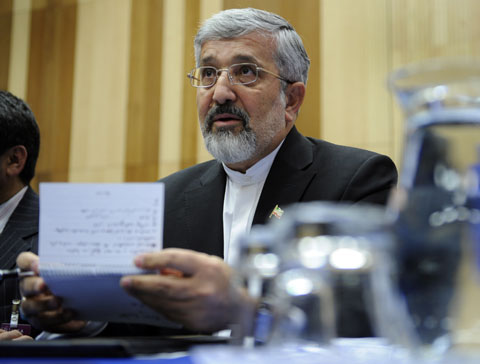Vienna Talks Test Obama Diplomacy
Seated across the table from the United States and its allies, the Iranian regime is considering an ambitious diplomatic offer to ship its uranium out of the country.
Jul 31, 20204.5K Shares571.5K Views
The Iranian ambassador to the IAEA, Ali Asghar Soltanieh 19 October 2009, during the Vienna nuclear talks with Iran in Vienna, Austria
Seated across the table in Vienna from the United States and its allies, the Iranian regime is considering an ambitious diplomatic offer to ship its uranium out of the country, a move designed to tamp down years’ worth of nuclear tensions. It isn’t clear if the Iranians will take the deal. But if the gambit ultimately succeeds, the Obama administration will have accomplished the one thing that that eluded the Bush administration, according to nuclear experts: it will have lengthened the time Iran would need to build an illicit bomb.
Diplomacy is underway to find out whether Iran will ultimately accede to an offer that the U.S. and its allies thought it accepted earlier this month: a proposal to reprocess 75 percent of its uranium stock outside Iran to a form suitable only for producing the civilian energy that Iran says it wants, and not a nuclear weapon. “If Iran ships the uranium out of the country, we’ve lengthened the fuse,” said Joseph Cirincione, the president of the Ploughshares Fund, a nonproliferation organization in Washington.
Illustration by: Matt Mahurin
Time Magazine reportedon Monday the backstory to that unexpected plan: the Obama administration came up with it months before, and secured Russian support for it in the summer during a trip Gary Samore, a White House aide, took to Moscow. For years, Russia has declined to criticize Iran harshly — giving it political credibility to remove Iran’s uranium, enrich it to a greater level, and then send it onto France for a final enrichment step. Once France takes that final step — converting the low-enriched uranium into “specialized plates that are used to produce the isotopes” for civilian nuclear power,” the magazine reported — it would return the uranium to Iran, now in a form unsuitable for producing a nuclear weapon without extreme technical expertise that Iran is not believed to possess.
At that point, Iran would be “irretrievably committed” to using the uranium for the civilian nuclear power it claims its nuclear program is designed to generate, said Ivan Oelrich, acting president of the Federation of American Scientists. “It would be a good move.”
On Oct. 1, Iran met with the so-called “P5+1″ powers — the U.S., Germany, Russia, France, Britain and China — after the disclosure of a previously unknown nuclear facility at Qom that is still under construction. At that meeting, not only did Iran agree to allow the IAEA inspections at Qom, but U.S. diplomats left the meeting with the impression that Iran had also agreed to an audacious plan to ship out 75 percent of its low-enriched uranium to Russia and France for reprocessing.
But since then, Iran has denied that it has reached any such deal to ship its uranium out of the country, and in response, the P5+1 convened this week’s meeting in Vienna. Talks are still ongoing, and could last until as long as Wednesday. Early reports indicatethat Iran is objecting to France’s role in the process, but it is not yet clear whether Iran will ultimately accept the deal. An anonymous diplomat quotedby The New York Times dismissed some rejectionist rhetoric from the Iranian delegation as “opening-day posturing.”
Understanding why the gambit would diminish the world’s fears over the Iranian nuclear program requires some technical explanation. The International Atomic Energy Agency, the world’s nuclear watchdog, knows that Iran possesses approximately 1,500 kilograms of low-enriched uranium at its nuclear facility at Natanz, which enriches that uranium from natural uranium hexaflouride, which comes from a different facility at Isfahan. Both those facilities are under IAEA safeguard, explained David Albright, the president of the Institute for Science and International Security. Uranium must be enriched to over 90 percent potency for a nuclear weapon, a process involving the separation of molecular densities through an arrangement of centrifuges.
How much high-enriched uranium would be needed for a bomb? “We reckon about 1,050 kilograms,” Albright said. So to remove 75 percent of Iran’s uranium stockpile would mean Iran would “need about 750 kilograms more to get back to point of having enough for one bomb’s worth,” he continued. With some adjustment for Iran’s “current rates of [low-enriched uranium] production,” Albright estimates that removing the uranium would buy “about 9-12 months” from any time necessary for Iran to achieve a nuclear weapon if it so desired. Estimates vary, but in August, the State Department’s intelligence branch — the only intelligence agency to correctly assess before the Iraq war that Saddam Hussein did not have a nuclear weapons program — concludedthat Iran could not produce enough uranium for a nuclear bomb until 2013 as thing currently stand.
If the Iranian regime ultimately accepts the international community’s plan to enrich its uranium outside Iran, it will allow the Obama administration to say that its diplomatic efforts have, for the first time, resulted in concrete steps that make it harder for the Iranians to get a nuclear weapon, buying time and cooling tensions in the post-Qom diplomatic scene. “It’s diff to make an absolute estimate,” Oelrich said. “You can do, ‘are we moving direction that make things safer or more dangerous?’ Clearly, I’d say, we’d move in the direction of ‘safer.’”
But no deal is completely airtight. Iran’s uranium supply comes from an indigenous mine called Gchine, and it has purchased uranium from South Africa as well. The IAEA does not safeguard the uranium until it reaches the nuclear facilities at Esfahan and Natanz. “Uranium from Gchine could have been diverted,” Albright said, adding it was “unlikely” that any South African uranium was.
If the Iranians reject the reprocessing proposal, the United States and its allies would be in a strong position to “rush to the U.N. with a sanctions package,” Cirincione said. He considered Iranian obscurity and intransigence on the proposal to fit in with a pattern of typical behavior, rather than an outright rejection. “The Iranians are masters of this,” he said, calling their position, “You show you the horse, we’ll show you a long list of conditions for what the horse costs.”
Similarly, there are already sanctions packages in Congress that gained political momentum after the Qom revelations. Last week, Rep. Howard Berman (D-Calif.), the chairman of the House Foreign Affairs Committee, announced that his committee will mark up a bill giving Obama the option to place sanctions on companies that seek to import petroleum to Iran, calling it a “fourth best option” if diplomacy fails and the U.N. does not approve multilateral sanctions.
Berman said his committee will mark up the bill on Oct. 28, and aides said they did not know what effect an Iranian nuclear deal at Vienna would have on the chairman’s schedule. Cirincione said any deal might provide a “strong argument not to pass it at all.”
Additionally, Cirincione said, any agreement reached in Vienna will bolster the Obama administration against its critics that argue, as probable 2012 GOP presidential contender Mitt Romney did on Monday, that any diplomatic outreach to Iran on the nuclear weapon is doomed to failure, a position embraced by the Bush administration. “Under the Bush administration’s watch, [Iran] got closer to bomb than it had ever been,” he said. “The bluster, the threats of regime change — not only didn’t it work, it made things worse.”
This article has been updated for clarity.

Hajra Shannon
Reviewer
Latest Articles
Popular Articles

